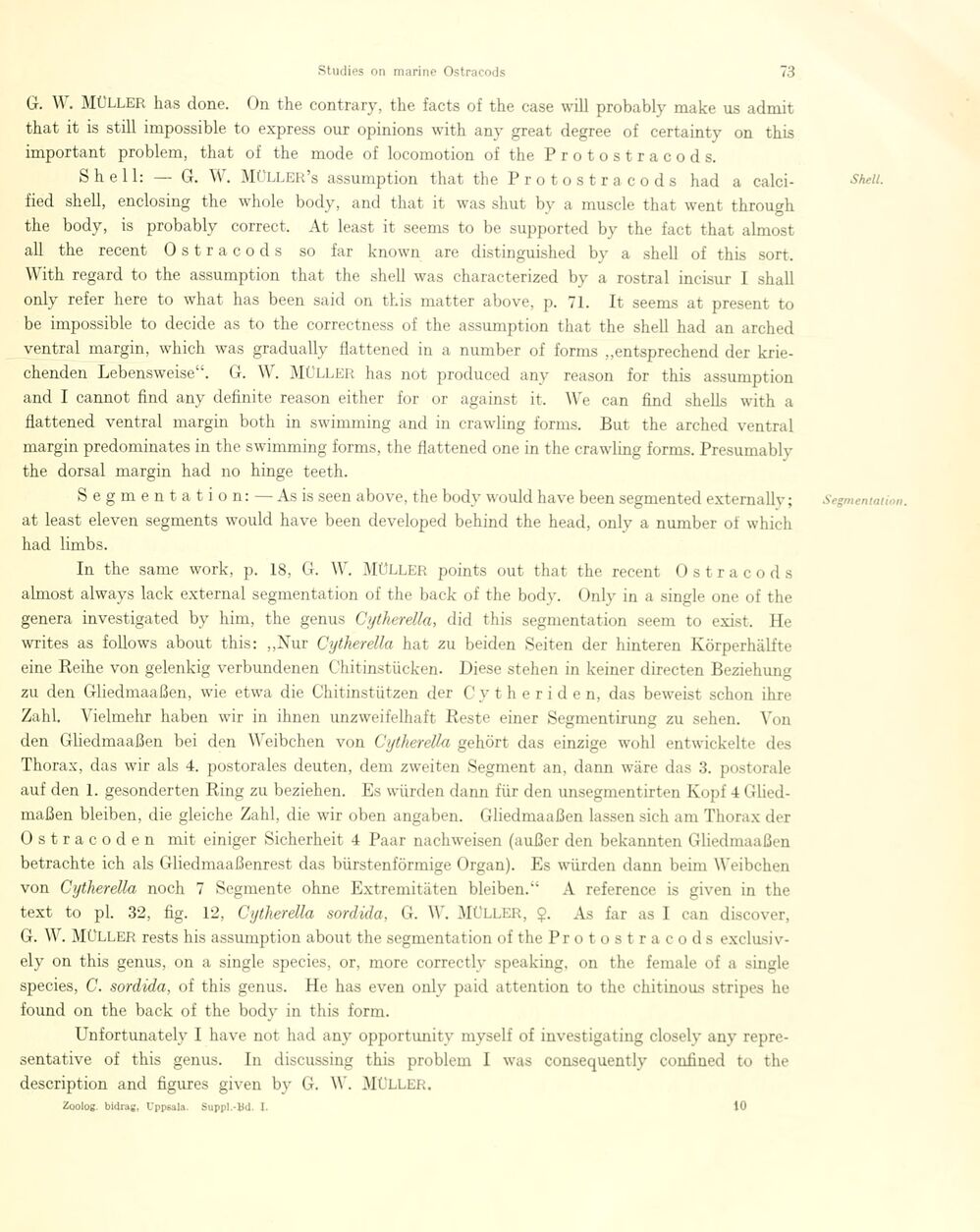
Full resolution (JPEG) - On this page / på denna sida - Sidor ...

<< prev. page << föreg. sida << >> nästa sida >> next page >>
Below is the raw OCR text
from the above scanned image.
Do you see an error? Proofread the page now!
Här nedan syns maskintolkade texten från faksimilbilden ovan.
Ser du något fel? Korrekturläs sidan nu!
This page has never been proofread. / Denna sida har aldrig korrekturlästs.
G. W. MÜLLER has done. On the contrary, the facts of the case will probably make us admit
that it is still impossible to express our opinions with any great degree of certainty on this
important problem, that of the mode of locomotion of the Protostracods.
Shell: — G. W. Müller’s assumption that the Protostracods had a
calci-fied shell, enclosing the whole body, and that it was shut by a muscle that went through
the body, is probably correct. At least it seems to be supported by the faet that almost
all the recent Ostracods so far known are distinguished by a shell of this sort.
With regard to the assumption that the shell was characterized by a rostral incisur I shall
only refer here to what has been said on this matter above, p. 71. It seems at present to
be impossible to decide as to the correctness of the assumption that the shell had an arched
ventral margin, which was gradually flattened in a number of forms „entsprechend der
kriechenden Lebensweise“. G. W. MÜLLER has not produced any reason for this assumption
and I cannot find any definite reason either for or against it. We can find shells with a
flattened ventral margin both in swimming and in crawling forms. But the arched ventral
margin prédominâtes in the swimming forms, the flattened one in the crawling forms. Presumablv
the dorsal margin had no hinge teeth.
Segmentation: — As is seen above, the body would have been segmented externally ;
at least eleven segments would have been developed behind the head, only a number of which
had limbs.
In the same work, p. 18, G. W. MÜLLER points out that the recent Ostracods
almost always lack external segmentation of the back of the body. Only in a single one of the
genera investigated by him, the genus Cytherella, did this segmentation seem to exist. He
writes as follows about this: „Nur Cytherella hat zu beiden Seiten der hinteren Körperhälfte
eine Reihe von gelenkig verbundenen Chitinstücken. Diese stehen in keiner directen Beziehung
zu den Gliedmaaßen, wie etwa die Chitinstützen der Cytheriden, das beweist schon ihre
Zahl. Vielmehr haben wir in ihnen unzweifelhaft Reste einer Segmentirung zu sehen. Von
den Gliedmaaßen bei den Weibchen von Cytherella gehört das einzige wohl entwickelte des
Thorax, das wir als 4. postorales deuten, dem zweiten Segment an, dann wäre das 3. postorale
auf den 1. gesonderten Ring zu beziehen. Es würden dann für den unsegmentirten Kopf 4
Gliedmaßen bleiben, die gleiche Zahl, die wir oben angaben. Gliedmaaßen lassen sich am Thorax der
Ostracoden mit einiger Sicherheit 4 Paar nachweisen (außer den bekannten Gliedmaaßen
betrachte ich als Gliedmaaßenrest das bürstenförmige Organ). Es würden dann beim Weibchen
von Cytherella noch 7 Segmente ohne Extremitäten bleiben.“ A reference is given in the
text to pl. 32, fig. 12, Cytherella sordida, G. W. MÜLLER, Ç. As far as I can discover,
G. W. MÜLLER rests his assumption about the segmentation of the Protostracods exclusi
v-ely on this genus, on a single species, or, more correctlv speaking, on the female of a single
species, C. sordida, of this genus. He has even only paid attention to the chitinous stripes he
found on the back of the body in this form.
Unfortunately I have not had any opportunitv myself of investigating closely any
representative of this genus. In discussing this problem I was consequently confiued to the
description and figures given by G. W. MÜLLER.
Zoolog, bidrag, Cppsala. Suppl.-Ud. I. 10
Shell.
Segmentation.
<< prev. page << föreg. sida << >> nästa sida >> next page >>